Running a small business in Australia comes with its own set of challenges — from managing inventory and finance to handling customer relationships and ensuring compliance. Investing in the right ERP software for a small business can help you organise your operations, enhance productivity, and promote growth.
What role does ERP software for small businesses play in improving operations?
In Australia, ineffective business management is a major factor in the difficulties faced by SMEs. An enterprise resource management system (ERP) is therefore a potent tool that can help us in saving a significant amount of time and money on everyday tasks. With an ERP that works for your business, you can handle finances, manage inventory, and improve customer satisfaction.
Let’s dive into the blog and explore what every small business should know before implementing ERP — plus the top 3 ERP solutions leading the Australian market.
How Can ERP Software for Small Businesses in Australia Transform Everyday Operations?
ERP software for small business is essential since it covers all aspects of the organisation’s operations. The top three benefits of using ERP, according to businesses, were a centralised data system, improved cooperation, and faster processing times.
Effective departmental collaboration is made possible by the ERP’s unified system. Before discussing the precise ways in which an ERP might assist you, it is important to clarify a few points:
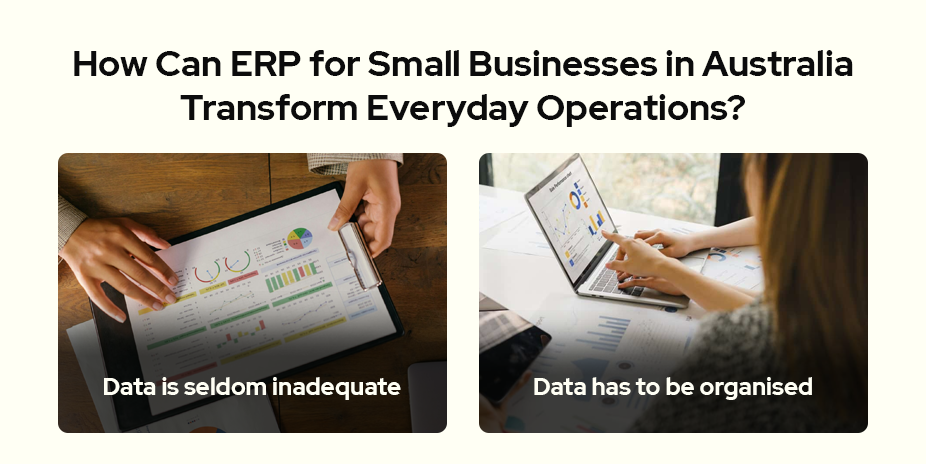
- Data is seldom inadequate
Data is rich regardless of the size of your business, and particularly in data-intensive sectors like manufacturing. ERP software may nevertheless provide useful insights from your provided data, even if your company is smaller.
- Data has to be organised
To run your business effectively, you must organise your data regardless of its volume. Understanding your financial situation, raw resources, labour, and production capacity is crucial in the production industry, for example. Operating as efficiently as possible is the objective.
How can you accurately assess the state of your company without a centralised system to collect data, report on procedures, and have a comprehensive view? ERP Software for Small Businesses will benefit any business in the following ways in 2025:
- Makes it easier for the team to comprehend their responsibilities.
- Facilitates a successful allocation of resources both internally and externally across departments.
- Offers a single source for inventory control, human resource management, production data, sales data, and more.
- Lowers the expenses related to human errors by utilising a single system for all organisational processes.
- Provides precise statistics and reporting to monitor performance, productivity, and development.
Therefore, implementing ERP for small businesses in Australia is not just a technological upgrade—it’s a strategic transformation. By centralising data, streamlining collaboration, and accelerating key processes, ERP empowers businesses to make smarter decisions, reduce costly errors, and stay agile in an increasingly competitive market.
Essential Factors To Consider Before Using ERP Software
Time is of the essence when it comes to the implementation of ERP software for small businesses in Australia, and every second counts. The best solution should address the majority of your business’s needs. Accounting, payroll, human resources, time and attendance, fixed assets, CRM, inventories, and more can all fall under this category.
Let’s go through all of the factors you must look for in an ERP system:
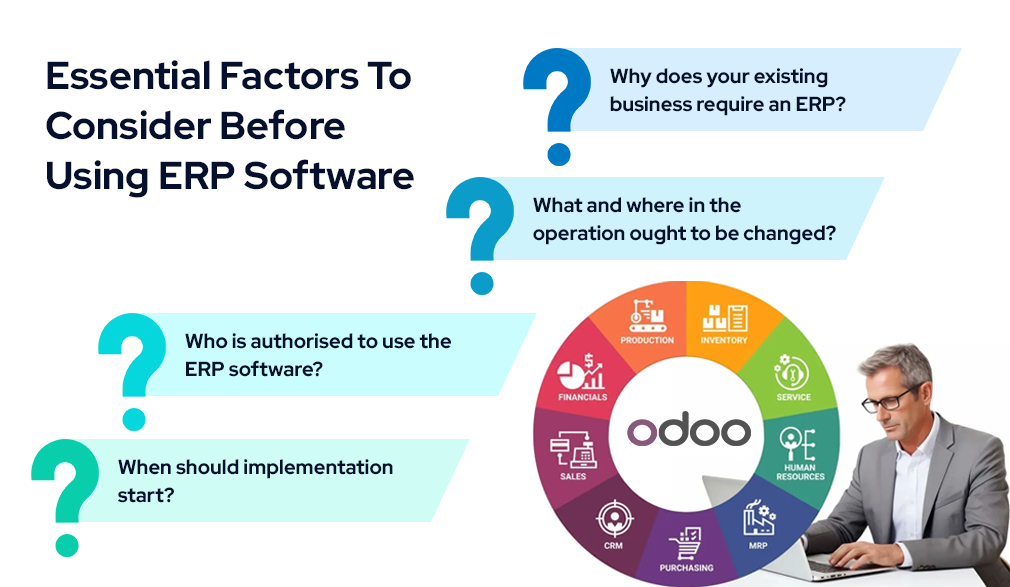
- Why does your existing business require an ERP?
Knowing the causes of changes in the organisation can help you spot them. Consider the customer Fencing Components (FC), whose outdated software solutions had poor communication. As a result, FC sought a comprehensive solution to optimise its business procedures. Their goal was to streamline every aspect of the business to boost output and deliver exceptional customer service. You could involve a few justifications in addition to your present company requirements, like:
- You’re struggling to manage your growth. For example, growing order quantities result in continuous difficulties with stock control.
- You are currently using outdated technology that is ineffective for your present process. For instance, processing documents is overwhelming your departments.
- Numerous signs of process disorientation are present in your teams. For example, improved procedures are needed to address safety issues on the manufacturing floor.
- The all-purpose spreadsheet has to be corrected or becomes too complex.
- Customers and partners are complaining, and you’re having trouble meeting their expectations.
- At any of these stages, an ERP might be considered, and here is when the process of finding the ideal one begins.
- What and where in the operation ought to be changed?
It is simpler to determine the connected areas that require adjustments after outlining the prior justifications. Returning to the Fencing Components situation, a number of areas need to be adjusted, including accounting, shipping, inventory control, and sales order management from various channels. In general, you may take into account elements like equipment, spreadsheet data, and administrative duties.
Clarifying your existing ERP software for small businesses and procedures, as well as how they benefit your business, is also necessary. Do you work for a food manufacturing firm that has created a unique batch and lot tracking system? Or a plastic company using a different accounting system to handle work orders and project costs? Make sure you understand your technological stack and assess the new ERP system’s adoption by employees.
- Who is authorised to use the ERP software?
Subordinates can perform responsibilities considerably more effectively if you provide them with the resources they need. Gallup’s analysis found a correlation between continuous communication and employee engagement. Better choices are made by managers and staff when they have more access to data from the company’s databases. Additionally, employees gain greater trust when they have greater access to the business’s operations and the goals of their job.
Fortunately, ERP offers more than just this type of access and promotes more efficient processes and communication. But it’s crucial to learn more about how the software works with your teams by:
- Discussing their responsibilities and the apps they utilise with everyone
- Inquiring about any issues they would like to resolve or believe may be handled more effectively
- Preventing missing critical facts, make sure all relevant parties are involved.
- When should implementation start?
When implementing ERP for small businesses in Australia, preparation and communication are important. Analyse the variables that could influence your implementation timeline and make the best possible plans for them. The following are some examples of typical impacts:
- Including and coordinating the appropriate internal resources
- The moment to ask your team what issues you want to resolve with a new ERP system
- Your essential staff and assets will be available throughout the implementation.
- Recording your present practices and determining what needs to be changed
- Organising and cleaning up your existing business data and choosing what you want to bring with you.
Adopting ERP software for small businesses successfully requires careful planning, effective communication, and a solid understanding of the objectives and difficulties facing your company today. Every stage is essential to a seamless transition, from determining the problems that require a shift to making sure that the correct people are involved and ready.
ERP Software’s Beneficial Elements for Small Businesses
ERP for small businesses in Australia should be updated and improved frequently. Since there should always be space for improvement, there is no requirement for a “perfect” system. An excellent enterprise resource planning system must be able to expand with you and your whole company. It must be flexible enough to meet any specific requirement. All things considered, the success of an ERP system depends on the following five essential elements:
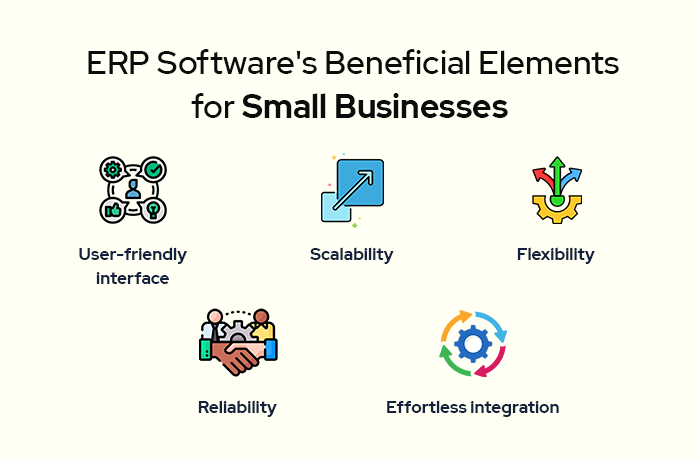
- User-friendly interface: The user interface should be easy to use, clear, and engaging.
- Scalability: After a few years of use, the ERP software should not become outdated and should be able to evolve with the business.
- Flexibility: The proposed solution must be customisable and accommodate a wide range of company types. It is anticipated to meet certain requirements and processes within the business or department in which it is utilised.
- Reliability: The software must operate dependably and be sufficiently secure to safeguard private information. To avoid any security threats, it shouldn’t be too difficult for you to swiftly deploy new features or problem patches.
- Effortless integration: Automating your business is now easier with robust integration options that provide additional state-of-the-art capabilities.
The Top 3 ERP Software For Small Businesses in Australia
Remember that a top ERP software for small businesses depends on your particular business needs, industry, size, and financial constraints. It’s essential to assess your demands and weigh your alternatives to choose what’s best for your business’s success.
Let’s know more about the top 3 ERPs listed below that best suit your business.
- Odoo
- Microsoft Dynamics 365 Business Central
- NetSuite ERP System
- Odoo
Since its inception in 2005, Odoo has grown to become a major force in the ERP industry worldwide. With more than 8,000,000 users globally, it has a flourishing user base and is gaining market dominance in Australia.
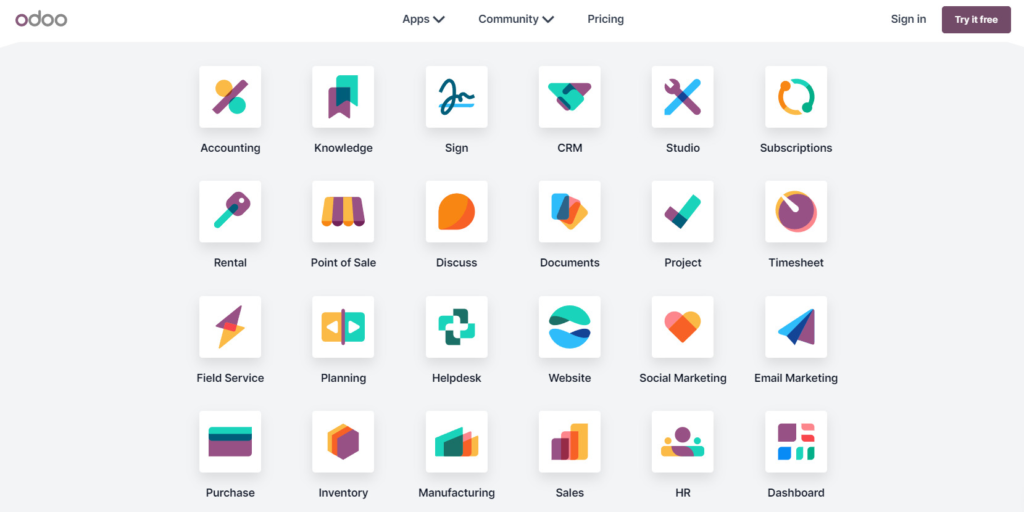
The combination of modular functionality and open-source flexibility is what sets it apart. Businesses can customise their ERP solution and only pay for what they need with the help of a library of over 10,000 possibilities. Odoo is a great option for Australian SMEs because of its affordable and adaptable strategy, user-friendly interface, and strong localisation. The best thing about odoo is:
- Open-source platform: Odoo distinguishes itself by offering a core version that is free and has all the capabilities that are needed. Because of this, it is a more affordable choice for small businesses, requiring smaller upfront expenditures than alternatives.
- Local features: Odoo has accounting, taxes, and reporting modules specifically designed to meet Australian needs. It ensures smooth adherence to ATO rules, simplifying processes for local businesses.
- Robust partner network: In Australia, Odoo has a wide network of approved partners. This ensures that businesses have access to local knowledge for modification, support, and deployment, all of which improve the ERP experience in general.
- Microsoft Dynamics 365 Business Central
Following Navision, a programme with over 100,000 users worldwide, Microsoft has made a very competitive entry into the ERP industry. With Outlook, Teams, LinkedIn, Power BI, Dynamics, and more, Microsoft now offers a comprehensive integrated business suite. Business Central might rank in the top three ERPs in Australia because of its dynamic setting.
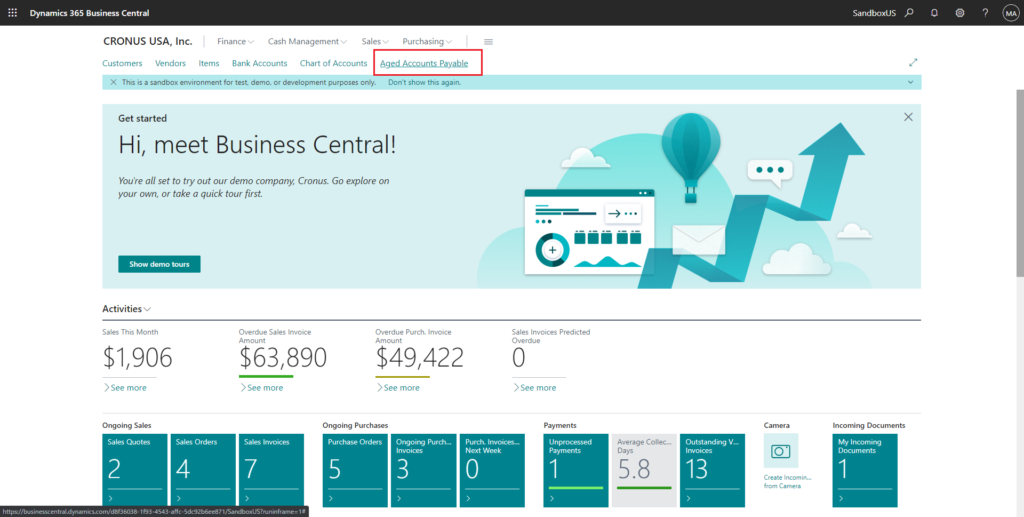
The best thing about this ERP is:
- Microsoft Office integration: The software easily connects with well-known Microsoft products like Office 365. For many Australian businesses, this improves user familiarity and experience.
- Efficient finance management: Robust financial management abilities meet intricate accounting requirements. Because of this, it’s a great option for businesses of all sizes with intricate financial systems.
3. NetSuite ERP System
By launching its cloud-based enterprise resource planning tools, NetSuite, now owned by Oracle, defied the conventional ERP frameworks. Today, NetSuite’s all-in-one business management suite serves over 37,000 clients globally, including several in Australia.
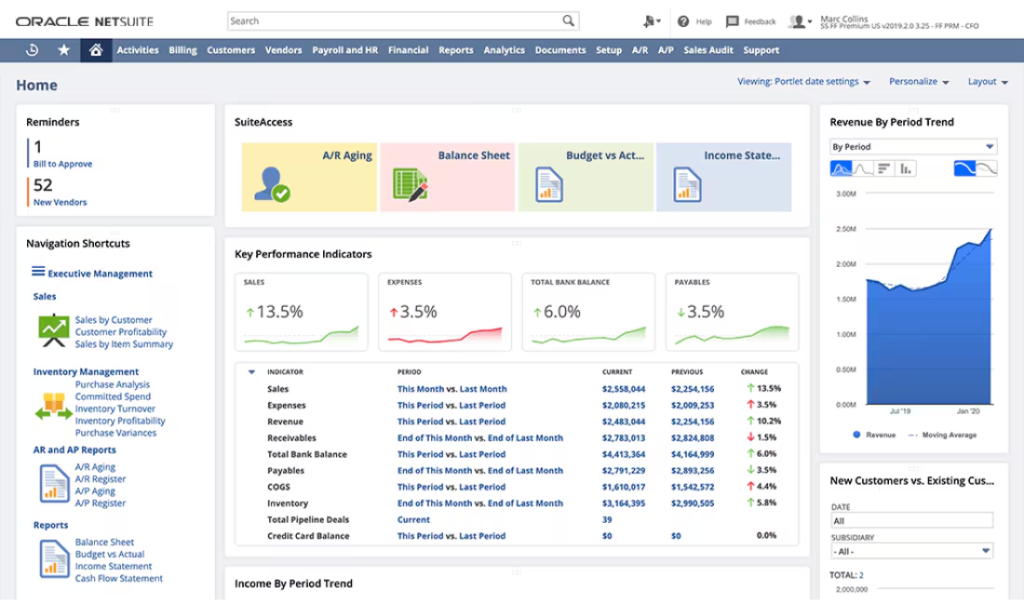
The best thing about this ERP is:
- All-in-one functionalities: Offers several interconnected modules, including e-commerce, cash management, finance, and inventory.
- Global and regulatory compliance: Apart from facilitating global operations, NetSuite complies with Australian accounting and tax laws. This makes accounting procedures easier for companies in many locations.
Summing up
Integrating ERP software for small businesses requires careful observation. make sure to draft an exhaustive business plan and identify any crucial requirements.
Focus on particular features and support when comparing well-known ERP solutions like Odoo, Microsoft, Acumatica, NetSuite, etc. This can help you meet your business requirements.


